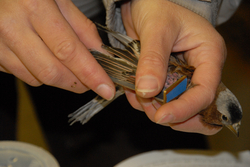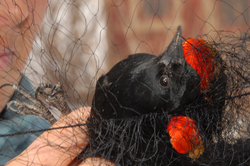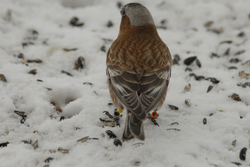Last week the Yampavian Ranch had the honor of hosting researchers from the Rocky Mountain Bird Observatory and the U.S. Forest Service. In my previous blog entry, I discussed how rosy-finches began showing up at our feeders on New Years Day. Their numbers grew over the weeks, until we were feeding close to 200 rosy-finches a day. 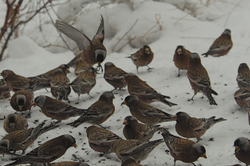
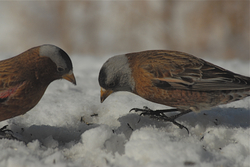
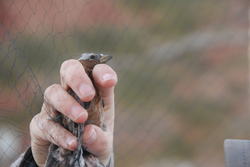
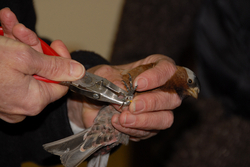


News of our flock traveled through the birding grapevine, and I was asked if I would allow researchers to band some of my rosy-finches as part of an on-going study of rosy-finches in Colorado. I was thrilled to give my consent; my dream for the ranch has always been both to attract and protect birds and to provide access to birders and researchers to learn more about the birds.
Three species of rosy-finches are found in a limited range in North America- Gray-crowned, Brown-capped, and Block Rosy-finch. All three frequent our ranch, with the Gray-crowned being the most numerous, by far. The photo above on the right shows the two different types of Gray-crowned Rosy-finches we see on the ranch; the bird to the left is the "Interior" Gray-crowned, and the one on the right with the "helmet" of gray is the "Hepburn" Gray-crowned Rosy-finch. Rosy-finches breed in high mountain tundra and migrate to lower elevations to feed on seed in winter months. Little is known about actual numbers of each of these species and how they are faring with climate change. Researchers from RMBO and the U.S. Forest Service are banding these birds to try to obtain more data on population numbers and movements of these species.
Early one morning this past week, the researchers arrived and set up a mist net in the area where the rosy-finches were feeding. Within a few minutes the first rosy-finches had flown into the net and were captured. The birds were gently removed from the net, placed in small

cloth bags, and taken to the banding station inside our heated garage. Each bird was then examined to determine age, sex, general feather condition, wing and tail length, and weight.
All of this information was recorded for each bird captured. Then each rosy-finch was banded with three different bands: a numbered, silver U.S. Fish and Wildlife band, a yellow plastic band indicating the bird had been banded in Routt County, and an orange plastic band which designates the year of the banding (2009-2010). Finally, the bird was released back into the wild with the new bracelets on its legs.

In addition to 46 rosy-finches (all Gray-crowned) captured over the two days of banding, we caught and banded a Black-capped Chickadee, several American Goldfinches, two Tree Sparrows, and two Red-winged Blackbirds.
These other birds were examined, measured, and weighed like the rosy-finches but were banded only with the single silver U.S. Fish and Wildlife band.
In years to come, we will look for the banded rosy-finches to see if they return to the ranch.
Already, we have spotted several of the banded birds back at the feeders, seemingly,
no worse for wear.
I find it thrilling that our ranch has not only been the chosen feeding grounds for these birds this winter, but has also been the chosen site to help learn more about these beautiful birds and their conservation.
